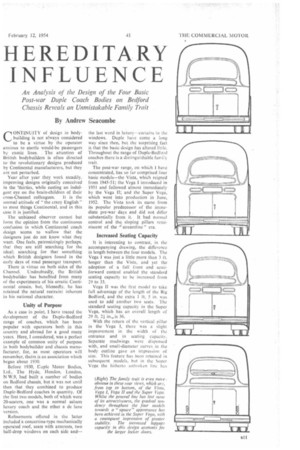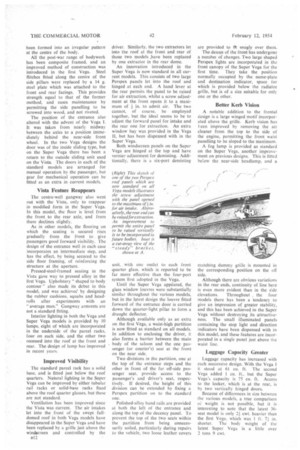HEREDITARY INFLUENCE
Page 45

Page 46

If you've noticed an error in this article please click here to report it so we can fix it.
An Analysis of the Design of the Four Basic Post-war Duple Coach Bodies on Bedford Chassis Reveals an Unmistakable Family Trait By Andrew Seacombe
CONTINUITY of design in bodybuilding is not always considered to be a virtue by the operator anxious to startle would-be passengers by exotic lines. . The attention of British bodybuilders is often directed to the revolutionary designs produced by Continental manufacturers, but they are not perturbed.
Year after year they work steadily, improving designs originally conceived in the 'thirties, while casting an indulgent eye on the brain-children of their
cross-Channel colleagues. it is the normal attitude of "the crazy English" In most things Continental, and in this case it is justified.
The unbiased observer cannot but form the opinion from the continuous confusion in which Continental coach design seems to wallow that the designers just do not know what they want. One feels, patronizingly perhaps, that they are still searching for the ideal; searching for that something which British designers found in the early days of road passenger transport There is virtue on both sides of the Channel. Undoubtedly, the British bodybuilder has benefited from many of the experiments of his erratic Continental cousin, but, blessedly, he has retained the natural restraint inherent in his national character.
Unity of Purpose
As a case in point, I have traced the development of the Duple-Bedford range of coaches, which has been popular with operators both in this country and abroad for a good many years. Here, I considered, was a perfect example of common unity of purpose in both bodybuilder and chassis manufacturer, for, as most operators will remember, theirs is an association which began about 1930.
Before 1930, Duple Motor Bodies, Ltd., The Hyde, Hendon, London, N W.9, had built a number of bodies on Bedford chassis, but it was not until then that they combined to produce Duple-Bcdford coaches in quantity. Of the first two models, both of which were 20-seaters, one was a normal saloon luxury coach and the other a de luxe version.
Refinements offered in the latter included a concertina-type mechanically operated roof, scats with armrests, two half-drop windows on each side and—
the last word in luxurycurtains to the windows. Duple have come a long way since then, but the surprising fact is that the basic design has altered little. Throughout the range of Duple-Bedford coaches there is a distinguishable family trait.
The post-war range, on which I have concentrated, has so far comprised four basic models—the Vista, which reigned from 1945-51; the Vega 1 introduced in 1951 and followed almost immediately by the Vega II; and the Super Vega, which went into production in June, 1952. The Vista took its name from its popular predecessor of the in.1211Cdiate pre-war days and did not differ substantially from it. It had normal control and the sloping pillars reminiscent of the 11 streamline" era.
Increased Seating Capacity
It is interesting to contrast, in the accompanying drawing, the difference in length between the four models. The Vega I was just a little more than 3 ft. longer than the Vista, and yet the adoption of a full front and semiforward control enabled the standard seating capacity to be increased from 29 to 33.
Vega 11 was the first model to take full advantage of the length of the Big Bedford, and the extra 1 ft, 5 in. was used, to add another two seats. The standard seating capacity in the Super Vega, which has an overall length of 29 ft. 2i in, is 36.
With the return of the vertical pillar in the Vega I, there was a slight improvement in the width of the entrance and in seating capacity. Separate mudwings were dispensed with, and small-diameter curves in the body outline gave an impression of size. This feature has been retained in subsequent models, hut in the Super Vega the hitherto unbroken line has been formed into an irregular pattern at the centre of the body.
All the post-war range of bodywork has been composite framed, and an improved method of construction was introduced in the first Vega. Steel flitches fitted along the centre of the side pillars were replaced by a 14 g. steel plate which was attached to the front and rear facings. This provides strength equal to that of the former method, and eases maintenance by permitting the side panelling to be screwed into wood, and not riveted.
The position of the entrance also altered with the advent of the Vega I. It was taken from nearly midway between the axles to a position immediately behind the near-side front wheel. In the two Vega -designs the door was of the inside sliding type, but on the Super Vega there has been a return to the outside sliding unit used on the Vista. The doors in each of the standard models are arranged for manual operation by the passenger, but gear for mechanical operation can be fitted as an extra in current models.
Vista Feature Reappears
The centre-well gangway also went out with the Vista, only to reappear in modified form in the Super Vega. In this model, the floor is level from the front to the rear axle, and from there declines slightly.
As in other models, the flooring on which the seating is secured rises gradually from the front to give passengers good forward visibility. The design of the entrance well in each case incorporates an intermediate step, and has the effect, by being secured to the side floor framing, of reinforcing the structure at the aperture.
Pressed-steel-framed seating in the Vista gave way to pressed alloy in the first Vega. Upholstery " shaped to body contour" also made its debut in this model, and was achievee by designing the rubber cushions. squabs and headrolls after experiments with an "average man." Gangway armrests are not a standard fitting.
Interior lighting in both the Vega and Super Vega models is provided by 10 lamps, eight of which are incorporated in the underside of the parcel racks, four on each side, and the other two recessed into the roof at the front and rear. The design of lamp has improved in recent years.
Improved Visibility
The standard parcel rack has a solid base, and is fitted just below the roof quarters. Natural lighting in the Super Vega can be improved by either tubular rail racks or solid-base raeks fixed above the roof quarter glasses, but these are not standard.
Ventilation has been improved since the Vista was current. The air intakes let into the front of the swept fulldomed roof in both Vega models have disappeared in the Super Vega and have been replaced by a grille just above the windscreen and controlled by the driver. Similarly, the two extractors let into the roof at the front and rear of those two models ,have been replaced by one extractor in the rear dome.
An innovation introduced in the Super Vega is now standard in all current models. This consists of two large Perspex panels let into the roof and hinged at each end. A hand lever at the rear permits the panel to be raised for air extraction, whilst a screw adjustment at the front opens it to a maximum of in. to admit air. The two cannot, of course, be employed together, but the ideal seems to be to adjust the forward panel for intake and the rear one for extraction. An extra window bay was provided in the Vega H, but has been dispensed with in the Super Vega.
Both windscreen panels on the Super Vega are hinged at the top and have vernier adjustment for demisting. Additionally, there is a six-port demisting unit. with one outlet to each front quarter glass, which is reported to be far more effective than the four-port system first adopted in the Vega.
Until the Super Vega appeared, the glass window louvres were substantially similar throughout the various models, but in the latest design the louvre fitted forward of the entrance door is carried down the quarter-light pillar to form a draught deflector.
Although available only as an extra on the first Vega, a waist-high partition is now fitted as standard on all models. In addition to enclosing the driver, it also forms a barrier between the main body of the saloon and the one passenger (or courier's) seat at the front on the near side.
Two divisions in the partition, one at the top of the entrance steps and the other in front of the far off-side passenger seat, provide access to the passenger's and driver's seat, respectively. If desired, the height of this division can be extended by fixing a Perspex partition on to the standard one.
Polished-alloy hand rails are provided at both the left of the entrance and along the top or the decency panel. To prevent the top of the two seats within the partition from being unnecessarily soiled, particularly during repairs to the vehicle, two loose leather covers
are provided to fit snugly over them.
The design of the front has undergone a numbei of changes. Two large shaped Perspex lights are incorporated in the front canopy of the Super Vega for the first time. They take the position normally occupied by the name-plate and destination indicator, space for which is provided below the radiator grille, but is of a size suitable for only one or the other.
Better Kerb Vision
A notable addition to the frontal design is a large winged motif incorporated above the grille. Kerb vision has been improved by removing the air cleaner from the top to the side of the engine, permitting the front waist panelling to be sloped to the maximum.
A fog lamp is provided as standard on the Super Vega, another improvement on previous designs. This is fitted below the near-side headlamp, and a matching dummy grille is mounted in the corresponding position on the off side.
Although there are obvious variations in the rear ends, continuity of line here is even more evident than in the side elevations. Throughout , the four models there has been a tendency to give an impression of greater stability, and this has been achieved in the Super Vega without destroying its attractiveness. The small illuminated panels containing the stop light and direction indicators have been dispensed with in this model, and these features are incorporated in a single panel just above the waist line.
Luggage Capacity Greater
Luggage capacity has increased with each successive design. With the Vega 1 it stood at 61 cu. ft. The second Vega added 1 cu. ft.. but the Super Vega's capacity is 75 cu. ft. Access to the locker, which is at the rear, is by two vertically hinged doors.
Because of differences in size between the various models, a true comparison ol weight is not possible, but it is interesting to note that the latest 36seal model is only 21 cwt. heavier than the first Vega. which was 1 ft. 7', in. shorter. The ho(4 weight of the latest Super Vega is a little over 2 tons 9 cwt.




































































































